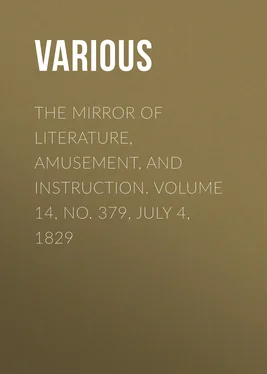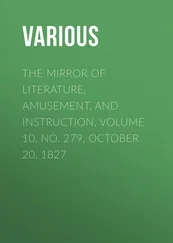Various - The Mirror of Literature, Amusement, and Instruction. Volume 14, No. 379, July 4, 1829
Здесь есть возможность читать онлайн «Various - The Mirror of Literature, Amusement, and Instruction. Volume 14, No. 379, July 4, 1829» — ознакомительный отрывок электронной книги совершенно бесплатно, а после прочтения отрывка купить полную версию. В некоторых случаях можно слушать аудио, скачать через торрент в формате fb2 и присутствует краткое содержание. Жанр: foreign_antique, periodic, Развлечения, foreign_edu, на английском языке. Описание произведения, (предисловие) а так же отзывы посетителей доступны на портале библиотеки ЛибКат.
- Название:The Mirror of Literature, Amusement, and Instruction. Volume 14, No. 379, July 4, 1829
- Автор:
- Жанр:
- Год:неизвестен
- ISBN:нет данных
- Рейтинг книги:4 / 5. Голосов: 1
-
Избранное:Добавить в избранное
- Отзывы:
-
Ваша оценка:
- 80
- 1
- 2
- 3
- 4
- 5
The Mirror of Literature, Amusement, and Instruction. Volume 14, No. 379, July 4, 1829: краткое содержание, описание и аннотация
Предлагаем к чтению аннотацию, описание, краткое содержание или предисловие (зависит от того, что написал сам автор книги «The Mirror of Literature, Amusement, and Instruction. Volume 14, No. 379, July 4, 1829»). Если вы не нашли необходимую информацию о книге — напишите в комментариях, мы постараемся отыскать её.
The Mirror of Literature, Amusement, and Instruction. Volume 14, No. 379, July 4, 1829 — читать онлайн ознакомительный отрывок
Ниже представлен текст книги, разбитый по страницам. Система сохранения места последней прочитанной страницы, позволяет с удобством читать онлайн бесплатно книгу «The Mirror of Literature, Amusement, and Instruction. Volume 14, No. 379, July 4, 1829», без необходимости каждый раз заново искать на чём Вы остановились. Поставьте закладку, и сможете в любой момент перейти на страницу, на которой закончили чтение.
Интервал:
Закладка:
Various
The Mirror of Literature, Amusement, and Instruction / Volume 14, No. 379, July 4, 1829
MILAN CATHEDRAL
"Show the motley-minded gentleman in;"—the old friend with a new face, or, in plain words, THE MIRROR in a new type . Tasteful reader, examine the symmetry, the sharp cut and finish of this our new fount of type, and tell us whether it accords not with the beauty, pungency, and polish of the notings and selections of this our first sheet. For some days this type has been glittering in the printing-office boxes, like nestling fire-flies, and these pages at first resembled so many pools or tanks of molten metal, or the windows of a fine old mansion—Hatfield House for instance,—lit up by the refulgent rays of a rising sun. The sight "inspires us, and fires us;" and we count upon new letter bringing us new friends, and thus commence our Fourteenth Volume with new hopes and invigorating prospects. But what subject can be more appropriate for such a commencement, than so splendid a triumph of art as
situate almost in the centre, and occupying part of the great square of the city. It is of Gothic architecture, and its materials are white marble. In magnitude this edifice yields to few in the universe. Inferior only to the Vatican, it equals in length, and in breadth surpasses, the cathedral of Florence and St. Paul's; in the interior elevation it yields to both; in exterior it exceeds both; in fretwork, carving, and statues, it goes beyond all churches in the world, St. Peter's itself not excepted. Its double aisles, its clustered pillars, its lofty arches; the lustre of its walls; its numberless niches all filled with marble figures, give it an appearance novel even in Italy, and singularly majestic. The admirer of English Gothic will observe one peculiarity, which is, that in the cathedral of Milan there is no screen, and that the chancel is entirely open, and separated from the nave only by its elevation.
The pillars of the cathedral of Milan are more than ninety feet in height, and about eight in diameter. The dimensions of the church at large are as follow:—In length four hundred and ninety feet, in breadth two hundred and ninety-eight, in interior elevation under the dome two hundred and fifty-eight, and four hundred in exterior, that is to the summit of the tower. The pavement is formed of marble of different colours, disposed in various patterns and figures. The number of niches is great, and every niche has its statue, which, with those placed on the ballustrade of the roof, are reported to amount to more than four thousand. Many among them are said to be of great merit. Over the dome rises a tower or spire, or rather obelisk, for its singular shape renders it difficult to ascertain its appellation, which, whatever may be its intrinsic merit, adds little either to the beauty or to the magnificence of the structure which it surmounts. This obelisk was erected about the middle of the last century, contrary to the opinion of the best architects. Though misplaced, its form is not in itself inelegant, while its architecture and mechanism are extremely ingenious, and deserve minute examination. In ascending the traveller will observe, that the roof of the church is covered with blocks of marble, connected together by a cement, that has not only its hardness and durability, but its colour, so that the eye scarcely perceives the juncture, and the whole roof appears one immense piece of white shining marble. The view from the summit is extensive and even novel, as it includes not only the city and the rich plain of Milan, intersected with rivers and canals, covered with gardens, orchards, vineyards, and groves, and thickly studded with villages and towns; but it extends to the grand frame of this picture, and takes in the neighbouring Alps, forming a magnificent semicircle and uniting their bleak ridges with the milder and more distant Apennines.
The traveller, says Eustace, will regret as he descends, that instead of heaping this useless and cumbersome quarry upon the dome, the trustees of the edifice did not employ the money expended upon it in erecting a front, (for that essential part is still wanting,) corresponding with the style and stateliness of this superb temple. A front has indeed been begun, but in a taste so dissimilar to that of the main building, and made up of such a medley of Roman orders and Gothic decorations, that the total suspension of such a work might be considered as an advantage, if a more appropriate portal were to be erected in its place. But unfortunately the funds destined for the completion and repair of this cathedral are now swallowed up in the general confiscation. Had it been finished, and the western front built in a style corresponding with the other parts, the admirers of the Gothic style would have possessed one specimen perfect in its kind, and accompanied with all the advantages of the best materials, set off by a fine climate.
In materials, the cathedral of Milan surpasses all the churches of the universe, the noblest of which are only lined and coated with marble, while this is entirely built, paved, vaulted, and roofed with the same substance, and that of the whitest and most resplendent kind. The most remarkable object in the interior of this church is the subterranean chapel, in which the body of St. Charles Borromeo reposes. It is immediately under the dome, in form octangular, and lined with silver, divided into panels representing the different actions of the life of the saint. The body is in a shrine of rock crystal, on, or rather behind the altar; it is stretched at full length, drest in pontifical robes, with the crosier and mitre. The face is exposed, very improperly, because much disfigured by decay, a deformity increased and rendered more hideous by its contrast with the splendour of the vestments which cover the body, and by the pale ghastly light that gleams from the aperture above. The inscription over this chapel or mausoleum, was dictated by St. Charles himself, and breathes that modesty and piety which so peculiarly marked his character. It is as follows:
Of the statues crowded in and around this edifice many are esteemed, and some admired. Of the latter, that of St. Bartholomew is the first; it stands in the church, and represents the apostle as holding his own skin, which had been drawn off like drapery over his shoulders. The play of the muscles is represented with an accuracy, that rather disgusts and terrifies than pleases the spectator. 1 1 The following lines are inscribed on its pedestal, in Latin, and in English:— Lest at the sculptor doubtfully you guess, 'Tis Marc Agrati, not Praxiteles. This statue is reckoned worth its weight in gold.
The exterior of the chancel is lined with marble divided into panels, each of which has its basso relievo ; the interior is wainscoted, and carved in a very masterly style. The whole of the chancel was erected by St. Charles Borromeo.
In describing this magnificent cathedral, we have availed ourselves of abridging the description in Eustace's "Classical Tour," a work of high authority and sterling value on all subjects connected with the Fine Arts.
RUSTIC AMUSEMENTS
Three years ago you gave a pleasing illustration of " the Amusements of May
Читать дальшеИнтервал:
Закладка:
Похожие книги на «The Mirror of Literature, Amusement, and Instruction. Volume 14, No. 379, July 4, 1829»
Представляем Вашему вниманию похожие книги на «The Mirror of Literature, Amusement, and Instruction. Volume 14, No. 379, July 4, 1829» списком для выбора. Мы отобрали схожую по названию и смыслу литературу в надежде предоставить читателям больше вариантов отыскать новые, интересные, ещё непрочитанные произведения.
Обсуждение, отзывы о книге «The Mirror of Literature, Amusement, and Instruction. Volume 14, No. 379, July 4, 1829» и просто собственные мнения читателей. Оставьте ваши комментарии, напишите, что Вы думаете о произведении, его смысле или главных героях. Укажите что конкретно понравилось, а что нет, и почему Вы так считаете.












